Open for Joy!
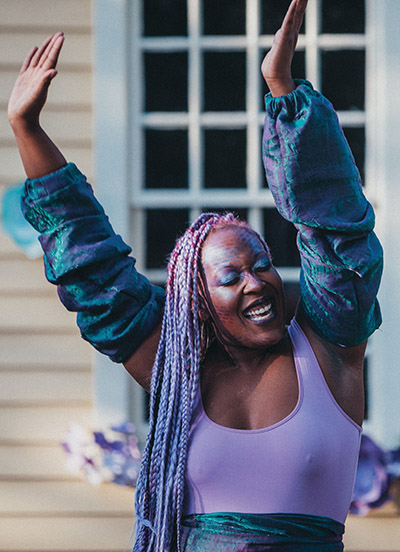
Photo: Stephanie Alvarez-Ewens.
Art venues across the region throw open their doors. It’s Christmas in July!
The Haus of Glitter Performance Lab
Providence, RI
theglittergoddesscollective.org/hausofglitterperformancelab
The Haus of Glitter Performance Lab shines as brightly as its name. An art house, dance company, record label, and community garden, they do it all (and look good while doing it). The organization is an offshoot of The Glitter Goddess Collective, a larger community of artists, performers, and activists dedicated to social, artistic, and spiritual liberation for queer and BIPOC individuals. Housed in the homestead of Revolutionary War commander and slave owner Esek Hopkins, Haus of Glitter seeks to disrupt the building’s narrative with “historic interventions” through their values and programming. “Our pursuit of joy as queer people of color drives us to center care in our creative process,” creative director Matt Garza explains. “It also feels like an act of protest. Joy is something we inherited from our ancestors, who had to find it in extremely difficult circumstances.”
Throughout the summer, Haus of Glitter is collaborating with local organizations and institutions to bring joy to the community. Presented in conjunction with AS220, weekly dance, yoga and meditation courses will be offered in the park and are open to all ages, with children participating for free with a paying adult. Working alongside the Providence After School Alliance, Haus of Glitter also offers free summer camps for youth and teens centered around environmental activism and social justice. Saturday, July 10, the organization hosts back-to-back events, beginning with Steez: a one-on-one dance tournament and mural art competition. Presented in collaboration with The.Park.Studios of Providence, Steez features some of the region’s top hip-hop dancers and muralists competing for prizes. Afterwards, attendees are invited to a dance party. While details are still forthcoming, Garza promises that it will be the “party of the summer!” On Monday, July 12 at 8 p.m., Haus of Glitter is partnering with the RISD Museum for a virtual singalong event to unite the community in song.
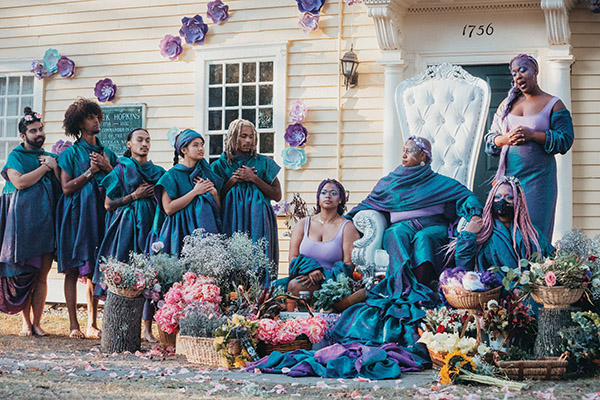
And that’s only the beginning. In September, the organization presents The Historical Fantasy of Esek Hopkins, a site-specific activist dance opera that rewrites the story of Esek Hopkins and imagines a world where slavery and colonization do not exist. Complete with an original script, score, and choreography, the opera draws upon stories and experiences from the Haus of Glitter’s Black, Indigenous, Latinx, and Laotian ancestry. For Garza, this production is a work of heart, and expresses gratitude for those who have supported the collective since 2019. “Our community has shown up for us again and again,” they explain, “This show is the best way we can say thank you for everything they’ve done for us.” The Haus of Glitter Performance Lab and The Glitter Goddess Collective shows us that joy, when shared with others, can be a powerful and unifying force for change and equity.
—Nicola Alexander
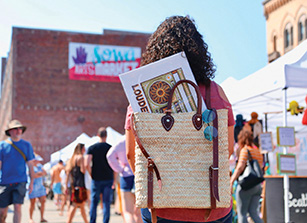
SoWa Art + Design District Open Market
Boston, MA
Sundays, 450 Harrison Avenue
sowaboston.com/sowa-open-market
Years ago, I visited 450 Harrison Avenue for the annual South End Open Studios. I fell in love with this old brick warehouse building that if the walls could speak, a best seller would emerge from its sordid tales. This area of the south end wasn’t exactly a tourist attraction at that time. They say of a person, it’s what’s inside that matters, and the same could be said of 450. The hard-working artists and gallerists, encouraged by SoWa’s landlord, GTI, forged a path that lead to this magical transformation into a vibrant neighborhood called SoWa (which stands for South of Washington). Today, Boston’s SoWa Art + Design District radiates JOY. At the heart is the SoWa Artists Guilds’ building at 450 Harrison, home to over 100 artists’ studios who open every day. In the basement is the SoWa Vintage Market where you’ll find treasures of all kinds. The best time to visit both the artists and SoWa Vintage Market is any Sunday all year long and the First Friday of every month. Along the charming brick walkway (Thayer Street), you’ll want to explore the many art galleries, unique boutiques, and design showrooms, which extend onto Harrison Ave. The SoWa Art + Design community is brimming with imagination and originality. And then, there’s Sunday…SoWa Sunday, when the vibe morphs into a celebration as the SoWa Open Markets take us over the top! I’m salivating just thinking about the SoWa Farmer’s Market…freshly baked bread, locally grown veggies, home-made pasta, raw honey, cheeses, chocolate, yum! And then there’s the carefully curated Arts Market where local makers sell their colorful array of hand-made goods. And do I hear food trucks in the distance? They will be returning to SoWa as well as the Beer Garden. And finally, the restaurants, some of Boston’s best are here. Yes, SoWa is back! Spend a day exploring Boston’s creative side.
—Debby Krim
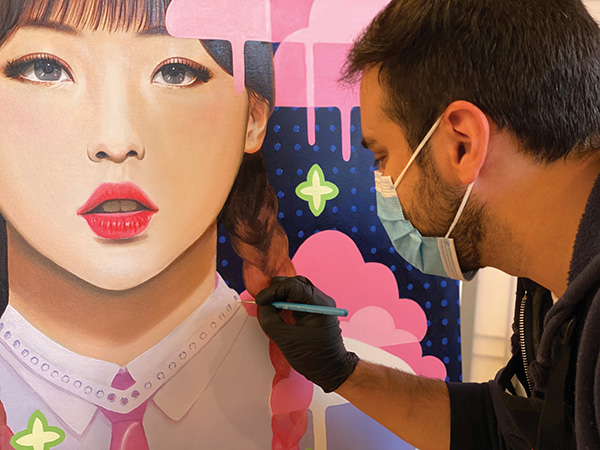
Breath: Zarah Hussain
at the Peabody Essex Museum
Salem, MA
Through April 2022
pem.org
“I would recommend anybody, sit down, take a deep breath, sit up straight. And try to breathe in slowly. Five seconds in and five seconds out. You will notice after five to ten minutes of doing that, you will feel so different.”
These are the instructions given by Zarah Hussain in an excerpt from PEMcast, the Peabody Essex Museum’s (PEM) podcast. Hussain is an artist known for bringing together science and spirituality in her art, most notably, her vibrant mandalas. In her latest exhibition at PEM, Hussain, takes on another dimension: our breath. Known for her passion in exploring the relationship between numbers and patterns in her work, in Breath, Hussain applies her gift to what brings us all together in ways that we may take for granted.
Hussain takes the concept of the perfect breath—which is 5.5 seconds—and a very personal experience to invite us to be truly present, given that we are all re-orienting ourselves to what it means to be with each other after this past year. The exhibition was inspired during a moment within the pandemic while Hussain was cleaning out her studio. She came across the “breath” paintings she’d done as she was recovering from surgery. “I was learning to breathe again, and I was learning to breathe correctly.”

Remembering to take a breath may sound silly, and in fact, prior to COVID-19, most of us did not think twice about our unobstructed access to breathing. However, within this landscape, the concept of breath has taken on new dimensions. On May 25, 2020, another layer was added to our understanding of the privilege with the death of George Floyd who told officers, “I can’t breathe,” as he was dying. Prior to the pandemic, amidst the intensity
and rush of our busy culture, breathing is something that many of us forget while going to work or going about our day.
As Hussain reminds us, breath is essential to life and it is something that we rarely think about until we don’t have access to it. She distills this point during her PEMcast as she shares, “It’s so distressing to feel that you can’t breathe properly cause it’s so primordial. It’s so linked to being alive that when you can’t breathe, I think it just triggers all sorts of things in your brain to think you’re dying.”
At this moment, it’s safe to say that we’re all becoming re-acquainted with our actual and metaphorical lungs as the country returns to some semblance of familiarity. And how perfect that an exhibition gives us the reminder, permission, and space to do so.
Breath is about our individual selves in connection to our bodies and to each other. Experience Breath, and take a moment to practice the art of breathing while getting lost in the colors and patterns presented within the museum space. Your body will thank you for it.
—Shanta Lee Gander
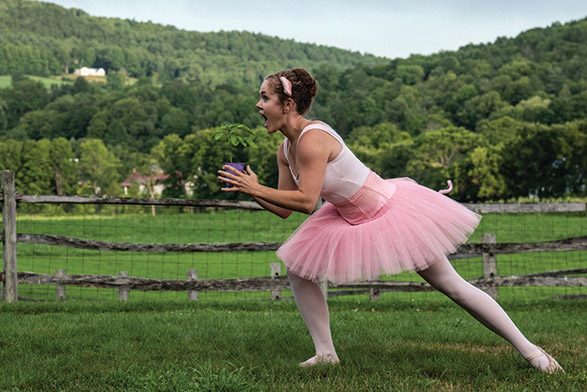
The Farm to Ballet Project
Multiple locations throughout Vermont
July 10–11, 17–18, 24–25
balletvermont.org/the-farm-to-ballet-project.html
It had been five years since Ballet Vermont’s artistic director Chatch Pregger and executive director Katie Decker realized their dream of combining their love of dance with supporting their home state’s ecologically sustainable agricultural economy in a unique educational and performance program called Farm to Ballet. Both Pregger and Decker are classically trained dancers. They were running their all-volunteer ballet company and teaching dance classes in a South Burlington studio when COVID struck bringing preparations for the 2020 performance season to a halt. Undaunted, they pivoted to teaching community-based dance classes online.
Farm to Ballet was an idea that had caught fire. Pregger and Decker had transformed the traditional corps de ballet of ultra-thin, tutu wearing dancers pirouetting across a stage to Tchaikovsky’s Swan Lake into something new that embodied the essence of Vermont. As a community-focused dance company they welcomed all body types, professionally trained dancers as well as serious beginners of all ages, opening the doors of dance to many worthy performers who might otherwise have been excluded. By partnering with local farmers, who in exchange for a share of proceeds from ticket sales offered their land as an outdoor performance space, Pregger and Decker found a way to support the food systems of the future through their art. Local musicians were also employed to accompany the dancers in a joy-filled program highlighting the seasonal rounds of an agriculturally based life that was a perfect fit for this rural state.
Their success left little time, however, for introspection or long-term planning beyond preparing the choreography and costumes for each season’s performances. The cancelation of their 2020 season provided Pregger and Decker, along with other key players, the time to look back as well as forward and engage in a visioning process. Decker explained, “Outlining our vision was very important. We took a big growth step, moving from an all-volunteer organization to getting the right people in paid positions. We invested in a donor management system. We moved our home base from Burlington to more centrally located Waterbury. I now have some clarity about our needs for the future.”
The move to Waterbury proved to be beneficial. The company had their strongest auditions to date this season. There are 23 dancers in Farm to Ballet and 17 dancers in Bees and Friends, a combination ballet and food festival exploring pollination, metamorphoses, pest management and bioluminescence set to Vivaldi’s Four Seasons. Vermont costume designer Emily Reynolds is creating 10 new chicken costumes this year. Decker says, “Emily loves textiles, she found a great ruffled fabric perfect for chickens. I really like the chicken dance. Dancers flap their arms like wings. It is very frantic.” These celebrations of life through the art of dance are a perfect way for families to enjoy being part of an audience again while supporting sustainable agricultural practices.
—Cynthia Close
New System Exhibitions
Portland, ME
newsystemexhibitions.com
Portland, Maine is gaining recognition as the vibrant place it is. Here, working fisheries sit beside coffee roasters and craft brew pubs. It is an eclectic place and US News and World Report recently named it as one of the top 25 cities in which to live and retire. In this mix, it is no surprise that it is also the perfect incubator space for some innovative ventures in the world of art.
New System Exhibitions is an artist run gallery, founded in 2018, that straddles the edge of working industrial and residential neighborhoods in the city. It is named for the old laundromat that occupied the space back in the 1970s. This seems apt since both the work on offer, and the operations of the gallery itself, are scrubbed clean of musty “must”s.

Frustrated by the lack of opportunities to exhibit their work, three recent graduates from nearby Bowdoin College contacted a few of their fellow artist friends and suggested they pool resources to renovate the existing (and somewhat dilapidated) industrial space they had been renting as a studio.
Now a vibrant three-room gallery co-managed by seven artists working collectively, the space provides opportunities for emerging or newly established artists to show their work.
This year, in response to increasing interest and an expansion of scope, the collective invited four members of the Portland arts community: Ashley Page (Indigo Arts Alliance), Veronica Perez (artist), Gelsey Amelia (New Fruit Art Collective), and Jenna Crowder (The Chart), to serve as jurors.
Weighing the merit of the work with the mission and values of the organization, they navigated the difficult task of paring down the offerings to a final selection for the summer season, a series of two concurrent solo shows, each running for 17 days.
Though the collective manages and curates the space itself, the artists selected maintain complete autonomy over exhibition curation, implementation, prices, and sales.
This summer’s exhibition schedule includes: July 2–18, Arnela Mahmutovic and Eden McDowell; July 30–August 15, Hannah Boone and Kenny Shapiro; August 27–September 12, Gil Corral and Liz Rhaney.
The works on offer are bright, vibrant, and dynamic, often reflecting the current relationship between our collective history and a still emerging future now that all the norms have changed. Fitting for a space which is actively redefining the gallery itself.
—Heather Martin
Garden for Boston: Elizabeth James-Perry and Ekua Holmes
at the Museum of Fine Art Boston
Boston, MA
mfa.org/exhibition/garden-for-boston
The Museum of Fine Arts, Boston is allowing two artists/activists to honor its Native land with a planted garden. In Elizabeth James-Perry’s installation, Raven Reshapes Boston: A Native Corn Garden at the MFA, the artist has planted a field of corn surrounding the site of (white) artist Cyrus Dallin’s bronze sculpture Appeal to the Great Spirit (1909). James-Perry, Aquinnah Wampanoag, was frustrated that she didn’t see images that reflected her culture. To address this, the artist is using centuries old planting techniques created by local Indigenous people to create the garden of corn, beans, and sedge. When fully grown, the stalks will surround Dalin’s sculpture reclaiming the space as a reminder of New England’s Native roots. “I wanted to bring something that was going to bring life and liveliness and motion and fluidity in a large way and corn does that,” says James-Perry.

Ekua Holmes has planted 3,000 sunflowers as part of her outdoor installation at the MFA, Radiant Community. It’s an extension of the Roxbury Sunflower Project, her neighborhood collaborative initiative to bring color and nature to Roxbury, MA, a historically Black area of Boston. The sunflower was chosen for its sturdiness, resilience and ability to grow in an imperfect terrain. Holmes has redefined the definition of a monument to mean something that can be sizable and that can grow from nature. As a young artist, she was supported by the people of Roxbury and now “this is a love letter back to my community,” says Holmes.
—Jennifer Mancuso
Norwalk International Cultural Exchange
Norwalk, CT
July 10, 11 a.m.–10 p.m.
norwalknice.org
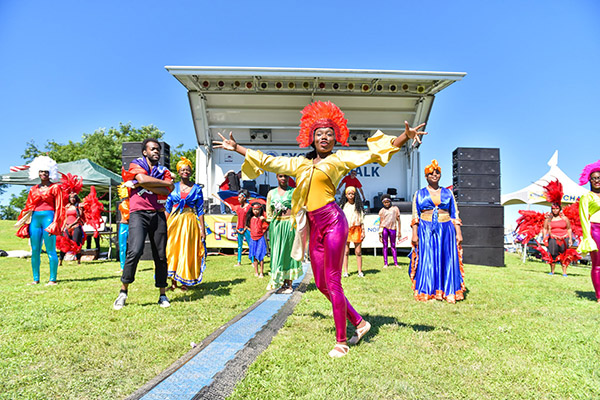
On July 10, get ready to celebrate summer! Experience different cultures through traditional folk art, delicious food, world sounds, and performing arts—including live dancers representing Flamenco, Asian, African, and other regions around the world—all within Norwalk, CT at the Norwalk International Cultural Exchange (NICE). The day-long NICE festival started in 2014 when executive director, founder, and Norwalk resident Janet Evelyn, approached the city with her vision of creating cultural events. “A number of our cultural festivals disappeared and some were very siloed.” After a year of discussions fueled by Evelyn’s passion to create a cultural event that would bring everyone together, Norwalk’s department of Recreation and Parks gave the green light.
This labor of love has grown to include what Evelyn describes as “intentional liaisons, partnerships and collaborations across multiple groups, organizations, and cultures.” It’s the perfect feel-good family daytrip—or treat yourself and friends—and imbibe these joyous expressions of culture. An additional focus this year includes live performances representing Laos, Thailand, Japanese Okinawan folk dance, and other celebrations of Asian culture.
As one of the main events marking Norwalk’s re-opening post-pandemic, the festival’s importance cannot be understated. “This is the revival of our community in the spirit of togetherness, health, and well-being. We’re also bringing all of these groups into this space to celebrate our inherent human desire to take care of each other.”
—Shanta Lee Gander
The Word Barn
Exeter, NH
thewordbarn.com
The Word Barn is nothing short of an idyllic New England setting. Run by Ben Anderson and his wife Sarah Alcott Andersen, the couple dreamed up a live-work scenario fit for a modern-day Robert Frost. For Sarah, a poet and teacher, and Ben, a concert promoter, the property is a fusion of both of their talents, wordsmith and music fanatic, making The Word Barn a venue for musicians and authors alike. When the couple isn’t hosting live shows, they provide nature programming, host writing workshops, harvest honey, raise chickens, and rent the space for corporate retreats. Attached to the property is also an apartment that serves as an Airbnb.
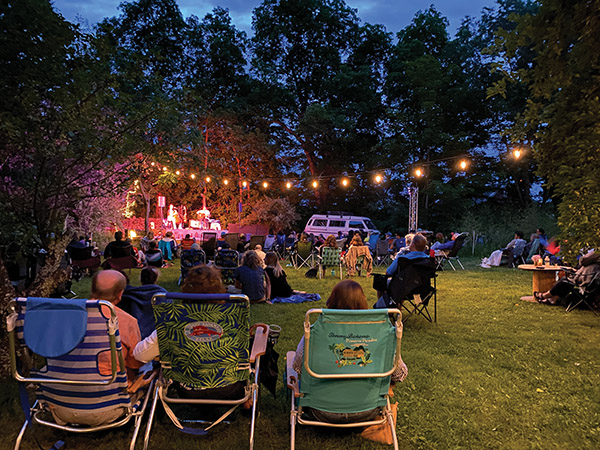
The Word Barn was hard hit during the pandemic yet Ben and Sarah quickly transformed their locale into a virtual destination and created a series of online workshops and music sessions. With the warmer weather last year, they began hosting outdoor events on a piece of their property they now call The Meadow. According to Ben, the response was overwhelming, and a strong indication of community support. Live music under a starry night with the occasional surprise visit by a food truck—summer bliss. Who knew this place could become even more magical? Watch for The Word Barn’s continuing outdoor concert series and Sarah’s long-awaited book of poems called We Hold on to What We Can, published by Loom Press.
—Jennifer Mancuso
